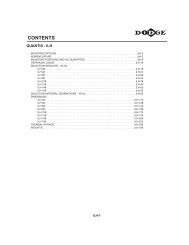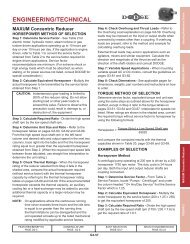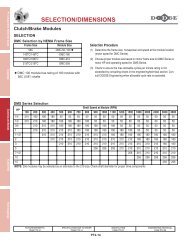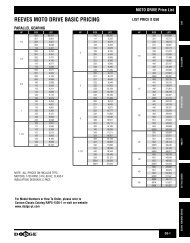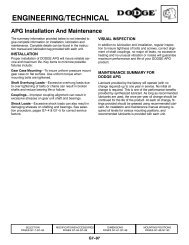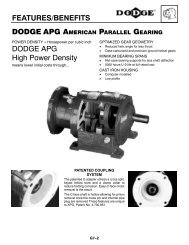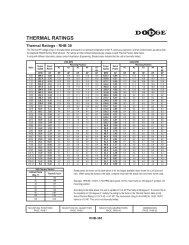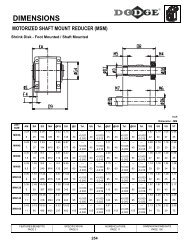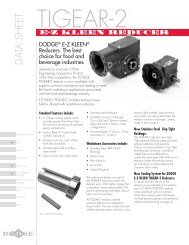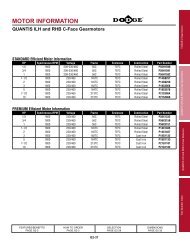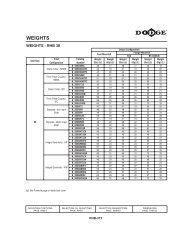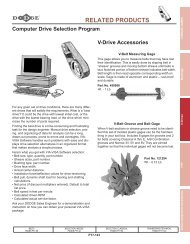MOUNTED Bearings Catalog Katalog eingebaute ... - Dodge-pt.com
MOUNTED Bearings Catalog Katalog eingebaute ... - Dodge-pt.com
MOUNTED Bearings Catalog Katalog eingebaute ... - Dodge-pt.com
You also want an ePaper? Increase the reach of your titles
YUMPU automatically turns print PDFs into web optimized ePapers that Google loves.
ISN SN Series HFO <strong>Bearings</strong> and Sleeves SLEEVOIL<br />
<strong>Bearings</strong> & Sleeves / Lager & Hülsen / Roulements & manchons /<br />
Rodamientos & Manguitos / Supporti & manicotti<br />
Load Ratings:<br />
Load ratings for Double Row Ball and<br />
Roller bearings supplied by DODGE are<br />
shown on pages B9-12 through B9-19 .<br />
These load ratings, in conjunction with the<br />
selection instructions shown below, will<br />
assist you in selecting the correct bearing<br />
for your application .<br />
Life:<br />
L 10 Life, Hours .—The life which may be<br />
expected from at least 90% of a given<br />
identical group of bearings operating under<br />
identical load, speed and environmental<br />
conditions .<br />
Bearing calculation:<br />
The selection tables on pages B9-6 through<br />
B9-11 help you select the bearings .<br />
To use these tables :<br />
1 . Define the L Life Hours desired .<br />
10<br />
2 . Establish equivalent bearing radial load<br />
P = (XFr [Radial load] + YFa [Thrust<br />
Load]); for Pure Radial Load Fr = P)<br />
3 . Establish RPM<br />
Under the RPM column, find the equivalent<br />
radial load that equals or is slightly higher<br />
than the application radial load for the<br />
desired life . The shaft size on the far left<br />
will be the minimum shaft size that you<br />
can use for your application . If the desired<br />
life is different than the values shown on<br />
the chart, use the following calculation<br />
method:<br />
For double row ball bearings:<br />
L = (C/P) 10 3 x (16667/n) ) – Equation #1<br />
For double row spherical roller bearings:<br />
L = (C/P) 10 10/3 x (16667/n) ) – Equation #2<br />
Where:<br />
C = dynamic capacity, pages<br />
B9-12 through B9-19<br />
P = equivalent radial load –<br />
equation #3 or #4<br />
n = RPM<br />
To use the above equation you must<br />
specify the L life required . Usually not<br />
10<br />
lower than 30,000 hours . Typical values<br />
are:<br />
Mining fans: 40,000 to 50,000 hours<br />
General purpose fans: 30,000 hours<br />
Conveyor Pulleys: 50,000 to 100,000<br />
hours<br />
Paper machinery: 100,000 hours<br />
Rotary furnaces: 30,000 hours<br />
You must establish the radial (Fr) and<br />
thrust load (Fa) acting on the bearings .<br />
The equivalent load, P, used in the above<br />
equations is obtained using:<br />
P = X x Fr +Y x Fa Equation #3<br />
1 1<br />
P = X x Fr +Y x Fa Equation #4<br />
2 2<br />
The values of X and Y are taken from the<br />
tables on pages B9-12 through B9-19 .<br />
The use of Equations #3 and #4 to calculate<br />
the equivalent radial load depends on the<br />
ratio of Fa/Fr . If Fa/Fr is ≤ e then Equation<br />
#3 is used . If Fa/Fr is > e then Equation #4<br />
is used . The values for L , P and RPM are<br />
10<br />
substituted into Equation #1 or Equation<br />
#2 and the value of C is calculated . The<br />
calculated value of C is <strong>com</strong>pared to the<br />
C values shown on pages B9-12 through<br />
B9-19 . The bearing having a C value equal<br />
to or greater than the calculated C is a<br />
suitable bearing size to select .<br />
Compare the application RPM with the<br />
maximum RPM permitted for the selected<br />
bearing to be sure it is not exceeded . If<br />
the speed of the application is higher<br />
than the grease limiting speed but lower<br />
than the maximum speed allowed with oil<br />
lubrication then an SNX type housing must<br />
be selected in conjunction with the bearing<br />
selected . The SNX housing may be used<br />
with static oil lubrication or circulating oil<br />
lubrication .<br />
If external heat is being introduced into the<br />
bearing via shaft or ambient temperature<br />
then an oil lubricated HFO should be<br />
considered . (Please ask for our catalogue .)<br />
Tragzahlen:<br />
Tragzahlen für zweireihige Kugel- und<br />
B9-2<br />
Rollenlager, die von DODGE geliefert<br />
werden, finden Sie auf den Seiten B9-<br />
12 - B9-19 . Diese Tragzahlen und die<br />
untenstehenden Formeln helfen Ihnen<br />
bei der Auswahl des für Ihre Anwendung<br />
korrekten Lagers .<br />
Lebensdauer:<br />
L 10 Lebensdauer, Std . – Die Lebensdauer,<br />
die mindestens 90 % einer größeren<br />
Anzahl gleicher Lager erreichen oder<br />
überschreiten .<br />
Lagerberechnung:<br />
Die Auswahltabellen auf den Seiten B9-6<br />
- B9-11 erleichtern Ihnen die Auswahl der<br />
Lager .<br />
Anwendung der Tabellen:<br />
1 . Bestimmen Sie die gewünschte<br />
Lebensdauer L . 10<br />
2 . Bestimmen Sie die äquivalente<br />
Radiallast P (= XFr [Radialbelastung]<br />
+ YFa [Axialbelastung]; bei reiner<br />
Radialbelastung ist Fr = P)<br />
3 . Bestimmen Sie die Umdrehungen pro<br />
Minute (U/Min .)<br />
Suchen Sie in der Tabelle die Radiallast,<br />
die gleich oder etwas höher ist als<br />
die Radiallast Ihrer Anwendung, und<br />
die der ermittelten Drehzahl (U/Min .)<br />
bzw . Lagerlebensdauer entspricht . Die<br />
Lagereinsätze im linken äußeren Teil der<br />
Tabelle sind geeignet für Ihre Anwendung .<br />
Falls Sie eine andere Lagerlebensdauer als<br />
in der Tabelle gezeigt benötigen, führen Sie<br />
eine Lagerberechnung wie folgt durch:<br />
Für zweireihige Pendelkugellager:<br />
L = (C/P) 10 3 x (16667/n) ) – Formel 1<br />
Für zweireihige Pendelrollenlager:<br />
L = (C/P) 10 10/3 x (16667/n) ) – Formel 2<br />
Wobei:<br />
C = dynamische Tragzahl (Seiten B9-12<br />
- B9-19)<br />
P = dynamische äquivalente Belastung)<br />
– Formel 3 oder Formel 4



